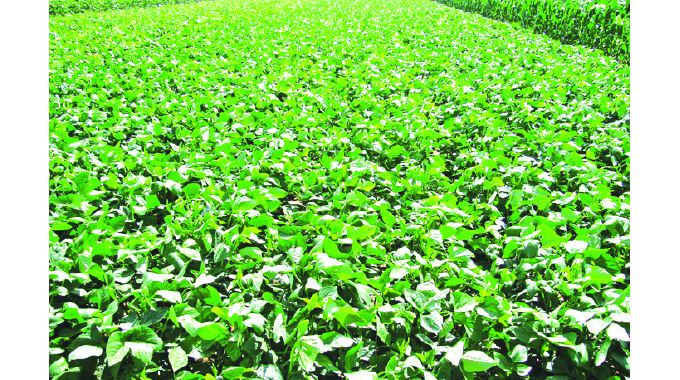Remember the Ides of 2021/22 cropping season!

Obert Chifamba Agri-Insight
A CUMULATIVE 377 517 hectares of maize, 61 959ha short of the 439 476ha planted during the corresponding period last season!
Such is the extent of disruption the false onset of the 2021/22 rainy season has caused in the manner in which farmers have being going about their activities guided by the rainfall amounts received in their different regions.
Information from the Ministry of Lands, Agriculture, Fisheries, Water and Rural Development’s latest weekly updates is, however, indicating that a cumulative 587 930ha have been put under summer crops with farmers continuing to plant despite receiving below normal rains.
According to Agritex, most areas have, in fact, received below normal rainfall compared with the long term average.
From the 377 517ha of maize planted so far, 95 136ha are under the Pfumvudza/Intwasa programme, 29 264 ha under Command while 256 666ha were planted by self-financing farmers or through other contractors.
Sorghum has so far been committed to 64 367ha compared to the 75 334ha that had been planted during the same period last year.
Farmers have also planted 35 940ha of pearl millet, 13 090ha of soya beans and 37 660 ha of cotton.
Under Pfumvudza/Intwasa, farmers planted 11 665ha of cotton while 25 995ha was funded by other contractors.
On the one hand, tobacco growers have planted 57 796ha compared to 59 245ha in the same period last year while 1 560 ha were put under sunflower amid growing calls by experts for farmers to speed up planting as there are projections of early cessation of the rains.
The rains are expected to end around March.
The experts are also urging farmers to grow short season varieties of maize, cotton and sorghum and late season crops such as cowpeas, sugar beans and sunflower.
Agritex director, Mr Stancilae Tapererwa recently observed that all Mashonaland provinces, Manicaland and the bulk of Matabeleland North had received below normal rains when compared with the long-term average to date adding that Midlands, Masvingo and most Matabeleland South provinces are in the normal category of their long-term average rainfall to date.
Since the start of season the highest cumulative rainfall amounts have been recorded at Gweru with 375mm, Kwekwe 280mm, West Nicholson 264mm, Harare’s Kutsaga 261mm and Nkayi 252mm, he said.
Low amounts have been recorded in Mashonaland Central where Chimhanda has recorded 46mm to date, Rushinga 45mm, Mt Darwin only 37mm, and Dotito 34mm while the evaporative rates are generally low due to the cloudy conditions that prevailed during the week December 15 to 22.
The first half of the 2021/22 cropping season (October to December) has since come and gone yet only a third of the country (mostly the southern part) has to date recorded normal rainfall since the start of the season with the bulk of the country still sitting below normal.
Most of the country’s accumulated rainfall amounts are ranging between 80 mm and 150mm.
Although there are glaring similarities between last season and the current one in terms of the delayed onset of the season, it still needs to be acknowledged that during the 2020/21 season, the little rains that fell in the first half allowed farmers to plant significant hectarages some of which either performed poorly or miraculously pulled through.
The fact that last season recorded a bumper harvest is an open secret even though the lavish rains that came in the last half had the potential to spoil the party if not properly managed.
This meant that farmers needed to be at their best to tame the potentially disastrous situation into a positive development like what eventually happened.
There are chances we may experience something similar to that given the fact that in recent times rainfall amounts that fall during most seasons are not very different yet the ever-changing distribution pattern is the chief culprit.
The long and short of it is that farmers now need to plan with the possibility of the unexpected turn of events in mind and when they purchase inputs, they should add some extras to come in handy in the event of either too much rains or too little.
In some cases, too much rains may affect germination or cause severe waterlogging and leaching of nutrients that will require farmers to either replant or do split fertiliser applications.
This is only possible where the farmer had planned for such eventualities, but this always comes with additional costs of production.
The small hectarage that has been planted is an indication that some farmers had put planting on hold waiting for the actual setting in of the rainy season so such farmers now need to think flexibly and where possible make changes to their crop variety choices.
Some crop varieties require long periods of time to grow to maturity, which makes them less ideal now as only three months of the season are remaining.
Weather experts have warned of the possibility of a mid-season dry spell rains and the sudden cessation of rains this season, which means that planted crops should also have grown to maturity before such an unfortunate conclusion to the season.
The other option farmers can take is to include late season crops such as cow peas, sugar beans and sunflowers in their crop choices so that they spread the risk in the event of outright crop failure.
It is also crucial for farmers to do split application of top dressing fertilisers if the rains come in copious quantities like they did last season so that the fertiliser is not washed away wholesomely.
Farmers that are still planting must do so expeditiously now and have in plan in place to manage weeds that may compete for nutrients with crops.
Those farmers who do not have adequate labour make arrangements for casual labour in advance so that they do not give weeds a chance to ruin their yields.
The war to contain weeds should also be accompanied by religious scouting for pests such as the fall army worm that can easily destroy entire crop fields if left uncontrolled.
Excessive rains are also known to bring diseases whose signs can be spotted if the farmers pay close attention to the day-to-day appearance of their crops.








Comments